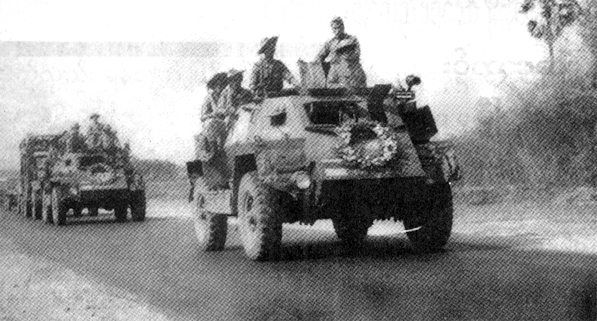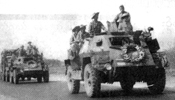Captain Tun Tin and his fellow officers of the 5th Burma Rifles were taking a break from ongoing battles with communists and Mujahedeen rebels in Arakan State. When off duty at their barracks, they usually tuned in to the radio for news and light entertainment.
An announcer suddenly broke into the broadcast with the dramatic words: “The Union of Burma is now facing a great danger.” The message was repeated three times and then the radio went off the air.
Two radio operators, Karen officers named Arthur and George, approached hurriedly and handed an incoming wireless message to Tun Tin. It read: “Attention 5 Burif, repeat Attention 5 Burif. Abandon Arakan, Repeat Abandon Arakan. Troops Dispatch Forthwith, Troops Dispatch Forthwith. Dakota Planes awaiting Akyab Airfield. Ack receipt, repeat Ack receipt.”
Then came the news that rebel soldiers of the Karen National Defense Organization had seized the Rangoon suburb of Insein.
Tun Tin and soldiers immediately left for the Sittwe (Akyab) airfield and boarded the Dakotas, planes of Indonesia’s recently launched Garuda airline, provided by the Indonesian government at the request of the newly formed Burmese government led by President Sao Shwe Thaike and Prime Minister U Nu.
Tun Tin’s commanding officer, Col Saw Myint, later recalled that it was the first time Burmese soldiers were airlifted to a battlefield—in this case, Rangoon.
As soon as he landed at Rangoon airport, Tun Tin half-jokingly told senior officers who briefed him on the Insein emergency: “We’ll go shopping in Insein within four or five days.”
It was January 1949, barely one year after Burma won independence from Britain.
Hostilities between the Karen and Burmans had been escalating since 1948 as Burmese troops tried to disarm Karen soldiers who had fought alongside Britain against the Japanese in World War II. Karen and Burmans shared a history of distrust and the Karen soldiers who had supported the British war effort feared they would be vulnerable to attack by Burmese troops if they surrendered their weapons.
When the Thirty Comrades led by Gen Aung San entered Burma with Japanese troops to liberate Burma from British rule, many Karen continued to support Britain, harassing the Japanese and providing intelligence to the British.
In the Irrawaddy delta region, the Karen population also resisted the new administration backed by the Burma Independence Army (BIA).
A rebellion in the delta was led by Shwe Htun Kya, who—according to Maj Kyaw Zaw, a member of the Thirty Comrades—commanded only about 100 armed men, who had refused to disarm and surrender their weapons. Retreating British officers left Shwe Htun Kya with arms and ammunition and reportedly told him: “We will be back soon. Keep up the resistance.”
Col Suzuki (aka Bo Moe Gyoe), who helped train Aung San and the Thirty Comrades, traveled to Myaungmya to investigate the Karen rebellion.
A Japanese colonel was killed during the mission and Suzuki ordered revenge. In Myaungmya alone, about 150 Karen, including former cabinet minister Saw Pe Tha, were executed by the BIA and Japanese troops.
The Karen retaliated by killing many Burmans.
In his autobiography, Kyaw Zaw acknowledged responsibility for much of the killing in the delta. Entering one town, Phyu, Kyaw Zaw found that 200 people had been killed by the Karen National Defense Organization (KNDO).
The violence spread to Rangoon, where Insein was taken over by the KNDO. Ne Win, the country’s new army chief of staff, removed senior Karen officers from the War Office and called in forces from the north and south.
Kyaw Zaw, a colonel and commander of the northern region, based in Maymyo, was among those recalled to the capital.
He recalled that as soon as he entered the War Office, Ne Win threw down a military map and thundered: “You are now in charge …go and fight the Insein battle.”
Kyaw Zaw replaced Brig General Aung Thinn, who was “permitted to retire” by Ne Win, who was suspicious of the southern commander’s loyalty.


